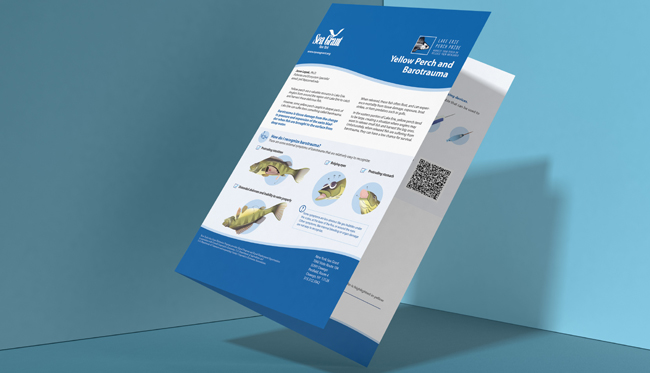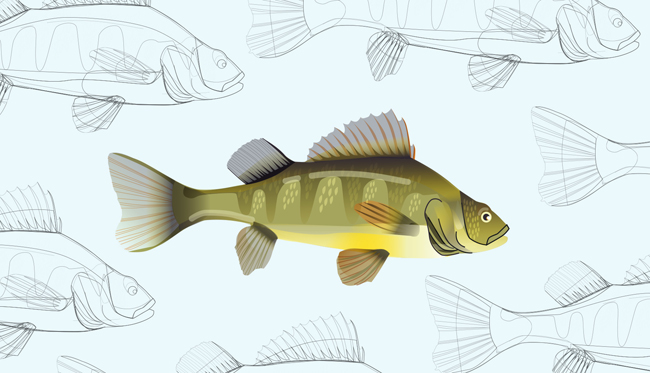
New York Sea Grant's "Yellow Perch and Barotrauma" fact sheet. Credit: Amaranta Delgado-Rodriguez.
Learn More in NYS Department of Environmental Conservation's Lake Erie Webinar on May 21st
Contacts:
Jesse Lepak, New York Sea Grant Great Lakes Fisheries and Ecosystem Health Specialist, E: SGOswego@cornell.edu, P: 315-312-3042
Kara Lynn Dunn, NYSG's Great Lakes Freelance Publicist, E: karalynn@gisco.net, P: 315-465-7578
Ithaca, NY, May 15, 2020 - New York Sea Grant (NYSG) announces publication of a barotrauma fact sheet (and videos) to help anglers address a condition that can occur in yellow perch caught from the deep waters of Lake Erie.
Lake Erie supports one of the largest freshwater fisheries in the world.
Barotrauma is tissue damage caused by a change in pressure and the resulting expansion of the swim bladder when fish are brought to the surface from deep water.
NYSG's illustrated “Yellow Perch and Barotrauma” fact sheet (pdf) includes information on how to recognize and address barotrauma in yellow perch.

In the eastern portion of Lake Erie, yellow perch can grow to large sizes, creating a situation where anglers may want to release small fish and keep the big ones as part of their harvest limit. Unfortunately, when released fish are suffering from barotrauma, they can have a low chance of survival. Credit: Amaranta Delgado-Rodriguez.
On May 21st, NYSG's Great Lakes Fisheries and Ecosystem Health Specialist Jesse Lepak will make a brief presentation on yellow perch and barotrauma as part of the New York State Department of Environmental Conservation “Status of Lake Erie and Upper Niagara Fisheries” Webinar at 7 pm. Details can be found at www.dec.ny.gov/calendar.
New York Sea Grant produced this fact sheet in partnership with Great Lakes Sport Fishing Council New York Director Thomas Marks; the New York State Department of Environment Conservation; Lake Champlain Sea Grant; Midstate Veterinary Services, Cortland, N.Y.; the Regional Science Consortium, Erie, PA; the University of Florida: Gainesville; and the University of Regina, Saskatchewan, Canada.
Barotrauma in Yellow Perch: Treatment - Venting or Fizzing
In the above video, NYSG's Jesse Lepak demonstrates a method for treating barotrauma in yellow perch called venting or fizzing. The procedure involves puncturing the swim bladder of the yellow perch with a hollow tool to release some of the gas it contains. If done properly, this technique can relieve pressure on some of the yellow perch tissues, and allows the fish to reduce buoyancy.
Barotrauma in Yellow Perch: Treatment - Descending or Recompression
In the above video, NYSG's Jesse Lepak demonstrates a method for treating barotrauma in yellow perch commonly called descending or recompression. The procedure involves using a tool to mechanically lower the perch below the surface and then release it. If done properly, this technique can relieve pressure on yellow perch tissues and allows the perch to reduce buoyancy.
More Info: New York Sea Grant
New York Sea Grant (NYSG), a cooperative program of Cornell University
and the State University of New York (SUNY), is one of 34 university-based
programs under the National Oceanic and Atmospheric Administration’s
National Sea Grant College Program.
Since 1971, NYSG has represented a statewide network of integrated
research, education and extension services promoting coastal community
economic vitality, environmental sustainability and citizen awareness
and understanding about the State’s marine and Great Lakes resources.
Through NYSG’s efforts, the combined talents of university scientists
and extension specialists help develop and transfer science-based
information to many coastal user groups—businesses and industries,
federal, state and local government decision-makers and agency managers,
educators, the media and the interested public.
The program maintains Great Lakes offices at Cornell University, SUNY
Buffalo, SUNY Oswego and the Wayne County Cooperative Extension office
in Newark. In the State's marine waters, NYSG has offices at Stony Brook
University in Long Island, Brooklyn College and Cornell Cooperative
Extension in NYC and Kingston in the Hudson Valley.
For updates on Sea Grant activities: www.nyseagrant.org has RSS, Facebook, Twitter, and YouTube links. NYSG offers a free e-list sign up via www.nyseagrant.org/nycoastlines for its flagship publication, NY Coastlines/Currents, which is published quarterly. Our program also produces an occasional e-newsletter,"NOAA Sea Grant's Social Media Review," via its blog, www.nyseagrant.org/blog.